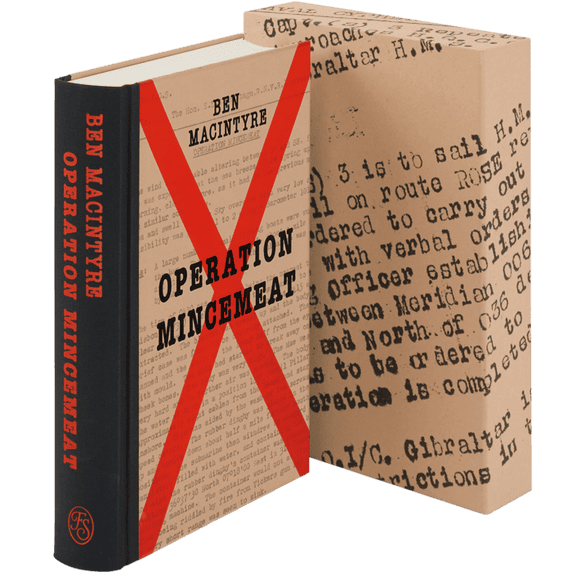
Ben Macintyre’s number-one bestseller Operation Mincemeat is the definitive account of the Second World War’s greatest military deception: a daring hoax that fooled Hitler and changed the course of history.
The D-Day Story, June 6, 1944
Introduced by Michael Shapiro
Afterword by the author
The Folio Society edition of The Longest Day commemorates the 75th anniversary of D-Day. Cornelius Ryan’s riveting text is complemented by 42 integrated photographs, and a binding image by Robert Capa.
’By morning an immense fleet of five thousand ships would stand off the invasion beaches of Normandy’
D-Day, the beginning of Operation Overlord and the Allied invasion of Europe, took place on 6 June 1944. Cornelius Ryan (himself at the heart of the action as Daily Telegraph war correspondent) spent 10 years interviewing over 1,000 participants to produce the most famous book ever written about D-Day. The Folio Society edition of The Longest Day has been issued as a stirring commemoration for the 75th anniversary of the D-Day landings. Ryan’s engaging narrative ensures that this work remains as accessible and illuminating as when it was first published in 1959, with the eponymous Oscar-winning film maintaining the book’s enduring and deserved celebrity. D-Day boasted the largest armada the world had ever seen, with nearly 5,000 ships carrying almost a quarter of a million soldiers and sailors. But rather than a conventional military history, The Longest Day places its emphasis on the people involved: the combatants on both sides and the civilians caught in the middle. Ryan draws on many captured German documents, including the war diaries and logs of Rommel, Von Rundstedt, and the German Seventh and Fifteenth Armies, to provide a compelling account.
Three-quarter bound in blocked cloth with a printed cloth front board
Set in in Dante with Universe as display
368 pages
42 integrated black & white illustrations, plus 4 maps
Printed map endpapers
Plain slipcase
10˝ x 6¾˝
Ryan traces the extraordinary events leading up to H-Hour of D-Day and the invasion itself. He considers the build-up of armed forces in the south of England, where countless men, supplies, ships and aircraft had assembled to await the signal that the invasion had begun. Meanwhile, in France, members of the Resistance received, via a BBC broadcast, the line of Verlaine poetry they had been waiting for: ‘Blessent mon coeur d’une langueur monotone’ – the invasion would begin in 48 hours. On the night of 5 June, thousands of Allied paratroopers were dropped into the Normandy countryside (one of whom landed in the garden of General Reichert and, on being questioned, informed the general, ‘Awfully sorry old man, but we simply landed here by accident’). The night saw great losses and greater heroism, including the taking of the formidable Merville Battery, but it was a prelude to the great show of the following day. As dawn rose above the Channel, some 5,000 ships were waiting off the Normandy coast – H-Hour of D-Day had arrived. On Omaha Beach American forces encountered withering fire, and at Pointe de Hoc US Rangers clambered up steep cliffs to disable guns that weren’t even operational. Elsewhere, Canadian divisions faced Russian and Polish volunteers, and British forces on Sword Beach were so unopposed they were able to be piped ashore to the strains of ‘Highland Laddie’. At the end of the day great losses had been counted on both sides, and little had gone according to plan, but the Allies had a toehold in Europe and the race for Berlin had begun.
The scenes and encounters of D-Day are depicted in 42 atmospheric black and white photographs which are fully integrated with the text. They portray such memorable subjects as Rommel inspecting part of the Atlantic Wall; an Allied convoy with protective barrage balloons; a Horsa glider being towed by an Armstrong Whitworth Albemarle; and American troops landing on Omaha Beach. The book’s endpapers contain the British army’s original maps of Omaha and Utah Beaches (prepared by Commander Task Force 122 a couple of months prior to the landings, they show beach obstacles and machine-gun pillbox positions), and four new specially commissioned hand-drawn maps depict the landing sites of the paratroopers and the invasion beaches. The sumptuous binding features an iconic image by the legendary Robert Capa, the first photographer to land on Omaha Beach. While he took over 100 photographs there, 89 were accidentally melted, and the blurred quality of his images is due to Capa’s trembling hands. Introduced by journalist Michael Shapiro, this edition also contains a new afterword (not featured in any previous version of The Longest Day) which combines two articles written by Cornelius Ryan after the book’s original publication.
Cornelius Ryan (1920–74) was born and educated in Dublin and began his career working for Reuters and then The Daily Telegraph. As a war correspondent for the latter he flew on 14 bombing missions before joining Patton’s Third Army, whose actions he covered from D-Day until April 1945 when he transferred to the Pacific and covered the end of hostilities in the Far East. In 1947 he moved to the USA to work for Time, and became a naturalised US citizen in 1951. Ryan is best remembered for his popular Second World War military histories, including The Longest Day (1959), The Last Battle (1966) and A Bridge Too Far (1974). He was awarded the French Legion d’Honneur in 1973.
Michael Shapiro is a journalist and author whose work has appeared in publications such as The New Yorker, Esquire, The New York Times Magazine and Sports Illustrated. He is the author of six non-fiction books, Japan: In the Land of the Broken-Hearted (1989), The Shadow in the Sun (1990), Who Will Teach for America (1993), Solomon’s Sword (1999), The Last Good Season (2003) and Bottom of the Ninth (2009). Shapiro is the founder of The Delacorte Review, a literary journal dedicated to narrative non-fiction, and is a professor at the Columbia Journalism School.
